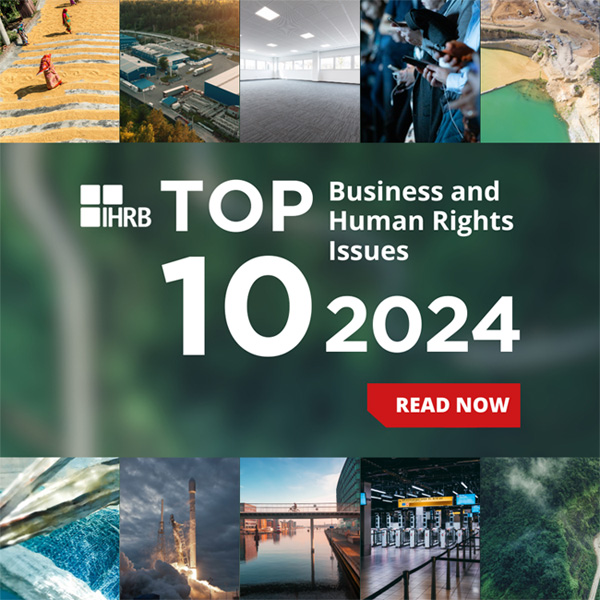Watch IHRB’s Salil Tripathi keynote address the launch of UNDP’s ‘Reporting Business and Human Rights: A handbook for journalists, communicators and campaigners’. In his keynote, Tripathi shares some examples from his career as a journalist and the importance of scrutinising the performance of states and companies in protecting and respecting human rights proactively, ass well as and especially when things go wrong.
About the publication
‘Reporting Business and Human Rights: A handbook for journalists, communicators and campaigners’ is the first guidance published by UNDP for reporting on business and human rights. Written by a journalist, with journalists, for journalists – the handbook is designed as a tool to help everyone from journalists, campaigners and activists developing their own stories to those conducting media and communications training better communicate business and human rights topics.
Salil Tripathi's Keynote Address
Reporting Business and Human Rights: A Handbook for Journalists, Communicators and Campaigners
29th September 2021
One December night in 1984 in the central Indian city called Bhopal, a cloud of gas leaked out of a fertilizer plant, swirling over the city. The gas was known as methyl isocyanate. It was poisonous, and little was known about its toxicity. It spread far and wide; the silent killer suffocated thousands of people that night in a city where poor people lived side-by-side with industrial complexes.
The plant was owned by an American company, Union Carbide, which manufactured the fertilizer for domestic consumption. When the accident occurred, much of India was in the middle of a parliamentary election. Up to 3,000 people died immediately, and close to 10,000 people, and possibly many more, had their life span shortened, dying much earlier than what they could have expected. Victims of that disaster continue to seek justice. American lawyers sought to represent Indian clients, but India argued before an American court that it had the capacity to try the corporation, and the US court sent the case to India. A deal was struck between the government and the company in 1987, with Union Carbide paying a lump sum, but survivors and victims’ families have continued to suffer poor health and are still fighting for justice. Later, Union Carbide sold its global business interests to another American corporation, Dow Chemicals. But the Indian subsidiary was hived off, sold to another Indian company.
Victims have sought justice from Dow Chemicals, as the parent corporation of the former Union Carbide, and Dow insists it has no responsibility for what happened in Bhopal that night, when it was nowhere on the scene. That is correct; Dow Chemicals did not own Union Carbide in 1984.
The gas leak was not a freak occurrence. The role of Union Carbide had been under the scrutiny of an intrepid journalist for some time. His name was Rajkumar Keswani.
Keswani, who died at the age of 71 in May this year, had been persistently reporting on failings at the Bhopal gas plant – he pointed out the shortcuts the inspectors made, the risks the plant posed in an area which was highly populated, and in the administrative and managerial short-comings. Few took notice of Keswani’s stories. And yet, his diligent reporting deserves far greater attention than he received. Journalists engaged in reporting the human drama, need to follow his footsteps.
In the next few minutes, I shall identify what those steps are, and why this guidance, by the UNDP’s Asia-Pacific Business and Human Rights Hub, is so vital to enhance our understanding of what makes the world work and how journalists can tell stories to make those who wield power more accountable.
The Bhopal disaster is unique for the number of deaths, but sadly, it is part of a pattern. If you dig further, you will discover the 1956 scandal in Minamata in Japan, where the release of mercury sulfate in the wastewater at a chemical factory owned by Chisso Corporation contaminated the city’s supply, creating a neural disorder that affected thousands, because the chemical metabolized into methyl mercury by the bacteria in the sediment. The plant continued to operate between 1932 and 1968, and thousands of lives were affected.
Let me turn to another disaster: This year, 2021, is an important date for one of the fastest-growing economies in South Asia, Bangladesh, as the country celebrates the 50th anniversary of its independence from Pakistan. When Bangladesh emerged as a new nation, a state department official described it as ‘an international basket case.’ The international community assumed that Bangladesh would remain the poster-child of poverty; its budget would be made up of grants from weary, angst-ridden Western Governments. Today, Bangladesh has superior social and human development indicators than many countries in its neighborhood: It houses its poor better; educates its girls; offers superior healthcare; and children born to Bangladeshi mothers have better chances of a longer life expectancy than most of its neighbors. Bangladesh’s success rests on several factors – its overseas workers send billions of dollars in remittances, and its productive garment workers, many of them women, stitch the clothes that much of the western world wears today.
This garment exports saga is a glittering success story.
However, in 2013, a building called Rana Plaza collapsed in Dhaka, Bangladesh’s capital, and more than 1,100 workers died; many survivors have physical disabilities. The factory inspection had been inadequate; the building had added floors without getting proper authorization; the factories were working overtime to meet production targets for multinational brands; they competed with one another on cost because the global garment industry sought ‘fast fashion,’ where clothes are made cheaply in countries with low labor costs, and supplied efficiently to the world’s malls. That well-oiled, outwardly efficient supply chain has lifted millions of workers out of absolute poverty, but their existence is precarious. As the Covid-19 pandemic showed, when the factories closed, the workers were pushed back into poverty as there was no effective safety net.
The collapse of Rana Plaza led to the creation of two multi-stakeholder initiatives to address the problem, Accord and Alliance, which were effective insofar as they aimed to prevent a repeat of such a collapse. Rana Plaza was not the first disaster to strike Bangladesh – Bangladeshi and international reporters, trade union leaders, and human rights defenders had been crying hoarse for years about the conditions in which the factories operated. Over a hundred workers had died in a fire at a factory in 2012. It must be our hope that such disasters do not happen again.
Our understanding of the interplay between business, politics, and society is enhanced when we connect these dots. Regulatory failure leads to disasters, and disasters have adverse impacts on human rights. Eternal vigilance is the cost of liberty, as it has been said, and three independent actors cast the light in the dark alleys and hidden corners of global commerce. What is to be done with it, is up to us.
The three actors are union leaders, human rights defenders, and journalists. Union leaders champion rights at work; human rights defenders campaign to improve human rights for all; and journalists listen and observe, and tell stories that someone, somewhere wants to suppress. That is news; the rest is advertising. News may be the stuff between the ads, but without news, a newspaper is worthless.
Asian countries had focused on improving competitiveness by lowering barriers, and since the early 1990s there has been upsurge in foreign investment in manufacturing, transforming agrarian economies. Unions, civil society groups, and journalists are essential to ensure that the development is fair and just. Many reporters – local and foreign – have been highlighting stories involving the interplay of business, politics, and society and what it does to the people – in the Philippines, Maria Ressa has been fighting a valiant battle; in Indonesia, investigative reports by journalists and human rights groups have shown poor working conditions in plantations; wire agency reporters have exposed the role of unscrupulous, below-the-radar businesses engaged in human trafficking in the Bay of Bengal and the South China Sea; journalists have examined what has come to be known as khaki commerce in many parts of Asia, where the military-owned businesses skew developmental priorities; Australian journalists have closely scrutinized a controversial coal project by an Indian company in their country; and journalists have shown the role of timber and gem trading companies in Southeast Asia in perpetuating human rights abuses.
As we travel across Asia – from the football factories in Punjab in Pakistan to the shipbreaking facilities at Alang in Gujarat, India; from the brickmaking factories in Bangladesh to the rubber glove-making factories in Malaysia; canned seafood manufacturers in Thailand or construction projects in Singapore; cotton producing farms in Xinjiang, China, and the export processing zones in Sri Lanka – we find stories crying out for attention. We find human drama that adds a new dimension to our understanding of economics and dry statistics of gross domestic product growth. They also point out the failure of governments to protect human rights, the weaknesses of international standards and human rights mechanisms to safeguard rights, and the role business has played in maintaining the status quo.
This does not mean that everything wrong with the world, or every abuse affecting the poor, the dispossessed, the marginalized, and those who are denied their power, is because of business. Far from it. The role of the state – the unwilling one, and the unable one – is important. But this does mean that there is much more business can do to improve people’s lives, beyond what companies claim in their glossy brochures, and when they sign up to adhere to the aspirations of the Sustainable Development Goals. The responsibility is twinned – the state has the obligation to protect human rights; business has the responsibility to respect human rights. And yet, we find that there is the gap – between the rhetoric and the reality – and this is where it becomes necessary to identify remedies.
In fact, what I have just described – protect, respect, remedy – is not a magic formula. It reiterates what the world needs, and it has been established succinctly in the UN Guiding Principles for Business and Human Rights.
This is an appropriate moment to remember the pivotal role John Ruggie, former special representative of the UN Secretary General for business and human rights, played in drafting those principles and steering them skillfully through the labyrinthine corridors of power. Ruggie, who died last week, was an astute political scientist who understood how the world worked. He knew why it was important to bring along all stakeholders together, to build an architecture where companies would respect rights, as long as the state kept its part of the bargain – of protecting rights. And since Ruggie knew our world and its imperfections, he called for remedies that identify, prevent, and mitigate harms.
The framework is crystal clear and commonsensical. Ruggie’s legacy will continue to inspire many of us.
The stories of business impacts on human rights matter not only at the rarefied gabfests of Davos or Geneva; they affect lives on the ground.
One of the features of business journalism is the emphasis on growth and profits and stressing the positive. Clever public relations firms work assiduously to cultivate journalists to cast their clients in a positive light. Men and women in expensive business suits speak in achingly dull cliches about playing a meaningful role to make the world a better place, and toss in terms like sustainability, inclusiveness, and being a good corporate citizen. Companies can of course be the force for good. They are of course important – they create jobs, pay taxes, produce goods and provide services efficiently, and do make the world a better place through imaginative interventions and innovations. But aircrafts taking off and landing smoothly won’t make a good story. A delayed flight, a scheduling mix-up, baggage mishandled, and tragic crashes are newsworthy. It is when things don’t work as advertised or intended, that a reporter gets interested.
And there is a business angle to virtually every story that’s outwardly political or social. Reporting about business should not be mere reiteration of balance sheets, price earning ratios, corporate plans, the size of an initial public offering, or the insatiable search for unicorns. Good reporting requires that you look beneath the surface: Yes, a company is hiring more women in managerial positions; that is good. But when it has to downsize, are women employees on the shopfloor more likely to lose jobs? That is a more real story. When a company allows its workers to work from home, are women more likely to face stress, mental pressure, violence at home? Are they more likely to drop out? It is those stories a good journalist seeks.
The role of a business journalist is not to be a cheerleader for the corporate world, but to ask questions about the impact of business on the society. To be sure, it does not mean being critical of business – but skepticism is the cornerstone of journalism.
What should reporters do?
-
Listen to all sides: Not only corporate executives and their agents, but also the workers and members of society whose lives are impacted by the decisions.
-
Protect sources: There are good reasons why employees or representatives of communities impacted by a company’s actions may prefer anonymity. Your sources are rights-holders. Protect them; ensure they are not harmed.
-
Trust, but verify: Every assertion is a claim. Ask when a company claims it has done something; ask the activist for evidence, not opinion, when the activists blame a company for what could be systemic or governmental failure.
-
Understand complexities: Business stories are not only about one company gaining market share at the expense of the other, but the complexity of why companies have behaved the way they have done.
-
One size doesn’t fit all: After the coup in Myanmar, some companies may have good reason to stay on, if their withdrawal would lead to hundreds of thousands of women losing their jobs in the garment sector. At the same time, a company may be justified in leaving, if its continued presence leads to it becoming complicit in human rights abuses. A good reporter analyses those complexities.
-
Figure out where responsibility lies: The state has an obligation to respect, protect, and fulfill rights. Its unwillingness or inability to play its legitimate role does not mean a corporation has to substitute the state. A company has neither the mandate, nor the capacity, nor the authority, and often no expertise to replace the state. There is a good reason why East India Company is now a boutique brand and not a colonial power. Be wary of what you ask for; you might get it!
-
Draw on the framework: Based on the UNGPs, journalists should identify what is expected of the state and of the corporate sector, and raise questions about assumptions, challenge assertions, and go as far as the facts take them.
-
And let the reader/viewer decide: A journalist is not a propagandist; she is not an activist; he is not the sole arbiter of the truth. Journalists should provide accurate information and interpretation to the readers and viewers so that they can conclude what the truth is, and act accordingly.
This guidance is important. It clarifies why business and society are interlinked. It shows how a society’s progress is to be measured not only by the dollars and cents earned by shareholders and banks that have lent money to those businesses, but also by the hard efforts of the women and men at work.
The interplay between business and society has profound implications on governments, nations, and indeed the world. Pursuing stories with curiosity, persistence, and enthusiasm, raising questions about what doesn’t make sense, widening the range of sources, and explaining the story in clear terms is the duty of all journalists.
Political journalism isn’t all about bad news; business journalism isn’t all about good news.
The two affect one another – and its consequences reverberate through the landscape. And good journalists, like canaries in coal mines, can identify those rumblings that foretell tremors. Theirs is not to set the world right; their role is to tell those stories, and in the process, comfort the afflicted and afflict the comfortable, so that it is a slightly better world tomorrow, than what it was yesterday.
Journalists have to bridge the difference between the stock market and the bazaar, between in the investor and consumer, and give voice to the voiceless, recognize the power of the powerless, and give space to those who have rights but are denied access. It is a noble calling; may this guidance help journalists discover new ways of looking at stories that must be told.



